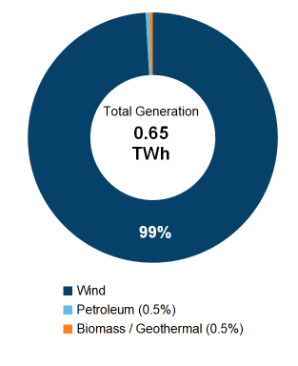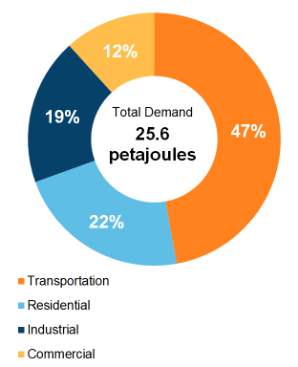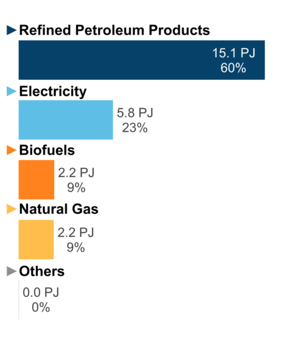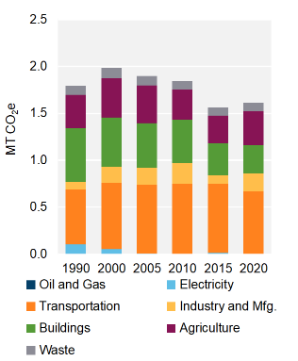Provincial and Territorial Energy Profiles – Prince Edward Island

On this page:
Connect/Contact Us
Please send comments, questions, or suggestions to
energy-energie@cer-rec.gc.ca
-
Figure 1: Electricity Generation by Fuel Type (2021)
Source and Description:
Source:
CER – Canada's Energy Future 2023 Data Appendix for Electricity GenerationDescription:
This pie chart shows electricity generation by source in PEI. A total of 0.61 TWh of electricity was generated in 2021. -
Figure 2: End-Use Demand by Sector (2020)
Source and Description:
Source:
CER – Canada's Energy Future 2023 Data Appendix for End-Use DemandDescription:
This pie chart shows end-use energy demand in PEI by sector. Total end-use energy demand was 25.2 PJ in 2020. The largest sector was transportation at 39% of total demand, followed by industrial (at 26%), residential (at 23%), and lastly, commercial (at 11%). -
Figure 3: End-Use Demand by Fuel (2020)
Source and Description:
Source:
CER – Canada's Energy Future 2023 Data Appendix for End-Use DemandDescription:
This figure shows end-use demand by fuel type in PEI in 2020. Refined petroleum products accounted for 15.1 PJ (60%) of demand, followed by electricity at 5.8 PJ (23%), biofuels at 2.2 PJ (9%), natural gas at 2.2 PJ (9%), and other at 0.0 PJ.
Note: "Other" includes coal, coke, and coke oven gas. -
Figure 4: GHG Emissions by Sector
Source and Description:
Source:
Environment and Climate Change Canada – National Inventory Report 1990-2022Description:
This stacked column graph shows GHG emissions in PEI by sector from 1990 to 2022 in MT of CO2e. Total GHG emissions have decreased in PEI from 1.78 MT of CO2e in 1990 to 1.60 MT of CO2e in 2022. -
Figure 5: Emissions Intensity from Electricity Generation
Source and Description:
Source:
Environment and Climate Change Canada – National Inventory Report 1990-2022Description:
This column graph shows the emissions intensity of electricity generation in PEI from 1990 to 2022. In 1990, electricity generated in PEI emitted 1,300 g of CO2e per kWh. By 2022, emissions intensity decreased to 2 g of CO2e per kWh.
Energy Production
Crude Oil
- Prince Edward Island (PEI) does not have any commercial crude oil production.
- Canada’s first offshore well was drilled 12 kilometres (km) south of Charlottetown in Hillsborough Bay in 1943. The well was dry.
Refined Petroleum Products (RPPs)
- There are no refineries in PEI.
Natural Gas/Natural Gas Liquids (NGLs)
- There is no natural gas or NGL production in PEI. PEI has some natural gas reservoirs, but only 20 exploratory wells have been drilled on and around the province to date.Footnote 1
Electricity
- In 2021, PEI generated about 0.61 terawatt-hours (TWh) of electricity (Figure 1), which is 0.1% of total Canadian production. PEI has an estimated generating capacity of 441 megawatts (MW).
- Roughly 99% of power generation on PEI is from wind farms. As of 2021, there was an estimated 268 MW of installed wind capacity on PEI.
- The majority of electricity consumed in PEI is imported from New Brunswick, which generates most of its electricity from a mix of nuclear, fossil fuels, and hydroelectricity.
- PEI’s largest wind farm is Engie’s West Cape Wind Park with a capacity of 99 MW.Footnote 2
- PEI’s latest large renewable electricity project is the 21 MW Sunbank solar farm and battery in Summerside, which was completed in late 2023.Footnote 3
- Diesel and oil-fired facilities are used to meet periods of peak power demand and during emergencies when wind generation or off-island imports are interrupted. Such facilities accounted for less than 1% of PEI’s total electricity needs in 2021.
- Most of PEI’s electricity transmission and distribution is provided by Maritime Electric Company Limited (Maritime Electric), a subsidiary of Fortis Inc.Footnote 4 Summerside Electric also supplies electricity to more than 7,000 commercial and residential customers throughout Summerside. Summerside Electric also owns and operates four wind turbines (combined 12 MW) and the Summerside Diesel Generation Plant, which generates up to 12.5 MW of electricity when needed.
- PEI Energy Corporation is a provincial Crown corporation whose mandate involves the promotion and development of energy systems on the island.Footnote 5 The Crown corporation operates wind farms atFootnote 6:
- Elmira (30 MW)
- Hermanville (30 MW)
- North Cape (10.6 MW)
- Norway (3 MW)
- The Renewable Energy ActFootnote 7 passed in 2005 required utilities to source a minimum of 15% of their energy from renewable sources (including out-of-province purchases) by 2010. In mid-2015, the act was amended to eliminate this requirement. In August 2023, changes to the act gave the provincial government authority to issue development permits for renewable energy developments.Footnote 8
- In 2019, PEI Energy Corporation proposed an expansion to double the 30 MW capacity of the Eastern Kings Wind Farm at Elmira.Footnote 9 However, the project was denied a permit by the Rural Municipality of Eastern Kings after receiving approval from the provincial government. The PEI Energy Corporation filed an appeal with the Island Regulatory and Appeals Commission (IRAC). In April 2023, the IRAC overturned the municipality’s decision. The corporation expects the turbines to be in service by September 2025.Footnote 10
Energy Transportation and Trade
Crude Oil and Liquids
- PEI is not connected to any crude oil or liquids pipeline systems. The province receives RPPs by ship.
Natural Gas
- PEI is not connected to any natural gas pipeline systems. A small amount of compressed natural gas is trucked into the province.
Liquefied Natural Gas (LNG)
- There are no current or proposed LNG facilities in PEI.
Electricity
- PEI is a net importer of electricity, with net interprovincial and international electricity inflows of 1.2 terawatt-hours (TWh) in 2023. PEI sources approximately 69% of its electricity from New Brunswick.Footnote 11 Electricity is transmitted between provinces by two subsea cables under the Northumberland Strait.
- The Interconnection Upgrade ProjectFootnote 12 was completed and placed in service in 2017. The project increased transmission capacity between New Brunswick and PEI by adding two new 180 MW subsea cables. The original two cables linking PEI and New Brunswick were installed in 1977 with a combined capacity of 200 MW.
- Power is distributed around the island on over 6,600 km of transmission and distribution power lines that are primarily owned and operated by Maritime Electric. The PEI Energy Corporation also owns transmission facilities in Prince County to connect its North Cape operations and other generators to the Maritime Electric grid.
Energy Consumption and Greenhouse Gas (GHG) Emissions
Total Energy Consumption
- End-use demand in PEI was 25.2 petajoules (PJ) in 2020. The largest sector for energy demand was transportation at 39% of total demand, followed by industrial at 26%, residential at 23%, and commercial at 11% (Figure 2). PEI’s total energy demand was the tenth largest in Canada, and the twelfth largest on a per capita basis.
- RPPs were the largest fuel type consumed in PEI in 2020, accounting for 15.1 PJ, or 60% of total end-use demand. Electricity accounted for 5.8 PJ (23%), while biofuels and natural gas each accounted for 2.2 PJ (9%) (Figure 3).
Refined Petroleum Products
- PEI’s motor gasoline demand in 2022 was 1,234 litres per capita, 19% above the national average of 1,035 litres per capita.
- PEI’s diesel demand in 2022 was 716 litres per capita, 7% below the national average of 772 litres per capita.
- Gasoline consumed in PEI is primarily produced at the Irving Oil RefineryFootnote 13 in Saint John, New Brunswick.
- The Irving Oil Terminal in Charlottetown receives gasoline, diesel, heating oil, and kerosene via ship. RPPs are then distributed throughout the island by truck.
- The Prince Edward Island Regulatory and Appeals CommissionFootnote 14 regulates provincial prices for gasoline, diesel, furnace oil, and propane. The Commission schedules price adjustments on gasoline, diesel, and furnace oil every Friday. Propane prices are set every second Friday.
Natural Gas
- A small amount of compressed natural gas is trucked into PEI for industrial use.
Electricity
- In 2020, annual electricity consumption per capita in PEI was 10.0 megawatt-hours (MWh). PEI ranked tenth in Canada for per capita electricity consumption and consumed 31% less than the national average.
- PEI’s largest consuming sector for electricity was commercial at 0.71 TWh. The industrial and residential sectors consumed 0.62 TWh and 0.28 TWh, respectively.
GHG Emissions
- PEI’s GHG emissions in 2022 were 1.6 megatonnes of carbon dioxide equivalent (MT CO2e).Footnote 15 PEI’s emissions have decreased 10% since 1990 and 15% since 2005.
- PEI’s emissions per capita are 9.6 tonnes CO2e. This is 47% below the Canadian average of 18.2 tonnes per capita.
- The largest emitting sectors in PEI are transportation at 42% of emissions, agriculture at 24%, and buildings (residential and commercial) at 19% (Figure 4).
- In 2022, PEI’s power sector emitted 1,154 tonnes of CO2e, a small fraction of Canadian emissions from power generation.
- The greenhouse gas intensity of PEI’s electricity generation was two grams of CO2e per kilowatt-hour (g CO2e/kWh) electricity generated in 2022. This is a 98% reduction from the province’s 2005 level of 120 g CO2e/kWh. The national average in 2022 was 100 g CO2e/kWh (Figure 5).
Energy Authorities
- Island Regulatory and Appeals Commission: Electric Utilities Regulation
- The Island Regulatory and Appeals Commission: Current Petroleum Prices
- Net Zero Atlantic
- PEI Energy Corporation
- CER–Canada's Renewable Power: Prince Edward Island
- Date modified:





